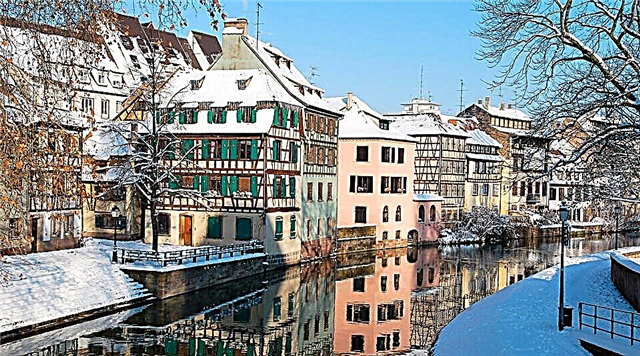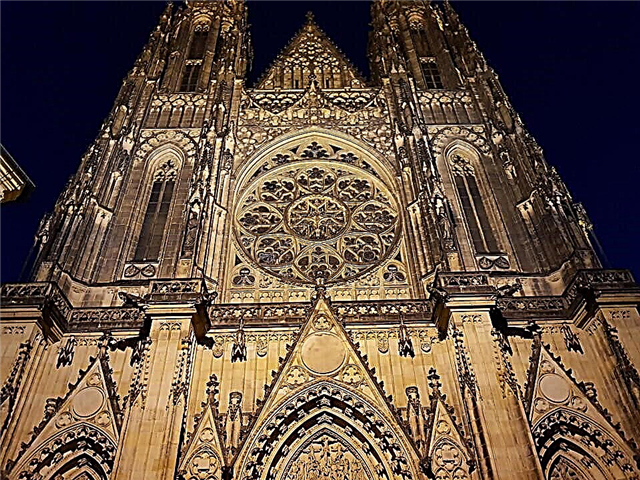At the top of the Hradcany Hill stands a monumental structure that embodies the spiritual symbol of the Czech state - the Cathedral of St. Vitus. This largest Prague temple, which is a Gothic masterpiece, is striking in its grandeur and beauty. Czech monarchs were crowned in the cathedral for a long time. Most of them rest in the cathedral's sumptuous chapels, adorned with precious stone wall frescoes.
Construction history

Initially, on the site where the basilica is now located, there was a temple dedicated to the god of fertility Sventovit. The ancient Slavs brought wine, roosters and rolls here to appease the idol. Significant changes in the consciousness of the people took place after the accession to the throne of Prince Wenceslas, brought up in the Christian faith.
In 925, the ruler of the Bohemian principality, Vaclav, built a rotunda on the site of a pagan temple, in which were placed the remains of St. Vitus of Rome, donated by the German monarch Henry I. The glory of the church increased over time, which led to an increase in the flow of pilgrims wishing to venerate the relics. A small structure 13.5 meters in diameter could no longer accommodate a large number of believers. In 1060, the rotunda was rebuilt into a rectangular building with three naves, separated from each other by columns. The building was significantly damaged during a devastating fire that engulfed the territory of Prague Castle at the beginning of the 14th century.

The construction of the cathedral began in 1344, when the Castle was already the seat of the archbishopric. The main concept for the construction of the new basilica was to create the main temple of Prague. Reigning at that time, Emperor Charles IV laid the foundation stone of the future church. The construction of a large-scale structure required a lot of money.
Charles IV increased taxes on silver mining and organized the sale of letters of absolution to believers. The talented French architect Mathieu was appointed in charge of the construction of the Gothic basilica. Under his leadership, the cathedral expanded in breadth and acquired eight new chapels. The architect failed to complete the project, because he died suddenly.
The next architect of the construction is a young sculptor and woodcarver Peter Parler from the Duchy of Swabia (southern Germany). He built the cathedral all his life until 1399. Under him, the ceiling of the temple was decorated with mesh vaults, the main altar, the Golden Gate, a chapel were installed, and the construction of the main tower of the cathedral with a clock began. Parler's sons continued the execution of their father's project, but the outbreak of the Hussite war and the feuds of medieval feudal lords for a long time suspended the construction of the cathedral. Only the decoration of some chapels continued.

The second half of the 16th century was marked by the completion of the clock tower and the installation of the largest bell in Europe. In 1673, Emperor Leopold I laid the foundations for new naves, which greatly increased the size of the basilica. Then a series of disasters followed again, which halted the construction of the temple - fires, lightning strikes and the invasion of the Prussian army. In 1770, the Italian architect Nicholas Pacassi gave the Gothic cathedral a certain baroque look, and crowned the tower with a dome. After the reconstruction, the basilica remained unfinished for about a hundred years.
In 1861, a special committee was organized to complete the construction of the cathedral. Under the leadership of the architect Josef Moker, work resumed on the unfinished buildings of the temple. Two western towers appeared. At the beginning of the 20th century, the famous artist Alphonse Mucha decorated the window openings of the cathedral with stained-glass windows. The final construction of the basilica took place in 1929.
South facade

The south facade of the basilica has a grandiose and magnificent view. It is decorated with massive lancet windows decorated with ornate lattices, carved stone ornaments and protruding vertical ribs with small pyramidal pillars. The lower tier contains the main gate, which consists of three arches.
The dominant structure of this part of the basilica is the clock tower topped with a baroque dome. Its height reaches 96 meters. The gilded movement has two dials, one above the other and separated by arched windows. The tower has four bells, one of which weighs 18 tons, the largest. A narrow medieval spiral staircase, consisting of 287 steps, leads to the observation deck, from where you can enjoy stunning views of the entire city.
West facade

The neo-Gothic western facade of the basilica, lined with lancet windows, cornices and openwork stone carvings, was built from 1873 to 1929. There are three Bronze portals here, each of which is framed by pilasters and crowned with patterned pediments. The gate panels are decorated with relief images representing scenes of the construction of the temple, as well as episodes from the life of Prince Wenceslas.
The western part of the cathedral ends with two Gothic pointed spiers. They rise up to 80 meters and are decorated with intricate cogged turrets. The jewel of the western façade is the Rose, a 10-meter-wide round window. It is decorated with stone patterns in the form of flower petals.
Golden Gate

The three-arched golden gate on the southern façade of St. Vitus Cathedral originally served as the main entrance to the basilica for the crowned heads. The portal is decorated with a magnificent unique mosaic consisting of one million glass fragments. All the stones were specially carved in Venice. Against the background of gilded glass cubes, a multi-colored drawing has been created that describes the biblical theme - the Last Judgment.
In the center of the composition is depicted Christ surrounded by the apostles. The left side of the mosaic shows saved believers ascending from their graves to heaven. On the right side are depicted sinners going into hellish flame to demons. The mosaics also show images of Charles IV and his wife. They are dressed in royal robes and kneel.
The gate is closed with a decorative bronze grill. Small allegorical sculptures of the signs of the zodiacs are installed on it. The figures of people are depicted in the course of various activities. They hunt, craft, harvest, plant trees, and more.
Interesting Facts

Vitus Cathedral was built with interruptions for almost 600 years. During the long construction period, the temple was transformed several times. The exterior and interior of the basilica have embodied a variety of architectural styles - from Gothic to Art Nouveau. Today the cathedral is considered a popular tourist attraction in Prague.
On the facade of the basilica, you can see all kinds of monsters, chimeras, demons throwing evil glances. Legend has it that they drive away evil spirits with their terrible appearance. In Gothic architecture, such statues are at the same time drainpipes.
The most important chapel dedicated to St. Wenceslas contains the Royal Treasury, which houses a golden crown adorned with precious stones, a scepter, orb, a ring and a sword. The jewels are hidden in a secret room, locked with seven locks, the keys to which have been distributed to various influential people in the Czech Republic. There is a legend that whoever takes possession of the crown illegally will be cursed forever.
There is a crypt under the cathedral, where the remains of Czech rulers from the Přemyslid dynasty, Luxemburgs, as well as some representatives of the Habsburg family, are buried in granite and tin sarcophagi.
Opening hours and ticket prices
Vitus Cathedral is open to tourists every day.You can visit the temple from 9:00 (Sunday from 12:00) to 17:00 (April-October), until 16:00 (November-March). In order to examine in detail the luxurious decoration of the basilica, you need to purchase a comprehensive ticket for all the sights of Prague Castle for 350 CZK. There is no separate ticket to enter the cathedral.
Where is it located and how to get there
The temple is located on a rocky hill in Prague Castle. Tram number 22 approaches the attraction. You should get to the Pražský hrad stop and walk 300 meters down the street. You can also use the metro. Malostranská station is located 400 meters from the basilica.











